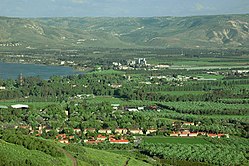Kvutzat Kinneret
| Kvutzat Kinneret | |
|---|---|
 |
|
| Coordinates: 32°42′48.24″N 35°33′45″E / 32.7134000°N 35.56250°ECoordinates: 32°42′48.24″N 35°33′45″E / 32.7134000°N 35.56250°E | |
| District | Northern |
| Council | Emek HaYarden |
| Affiliation | Kibbutz Movement |
| Founded | 1908 |
| Population (2015) | 685 |
Kvutzat Kinneret (Hebrew: קְבוּצַת כִּנֶּרֶת) (also Kibbutz Kinneret) is a kibbutz in northern Israel founded in 1913. Located to the southwest of the Sea of Galilee near Tiberias and next to Moshavat Kinneret, it falls under the jurisdiction of Emek HaYarden Regional Council. In 2015 it had a population of 685.
The name Kinneret derives from an ancient Canaanite town close to the northern end of the lake's western shore. According to the Hebrew Bible, the town of Kinneret was part of the allotment of the tribe of Naphtali (Joshua 19:35). The site of the modern kibbutz was probably also part of Naphtali, or (depending on interpretation) of Issachar or Zebulun. In the Bible, the Sea of Galilee is called Yam Kinneret, lit. Sea of Kinneret.
Kvutzat Kinneret, like Degania Alef, evolved from the agricultural training farm founded in 1908 known as Havat Kinneret (Kinneret Farm) or Hatzer Kinneret (Kinneret Courtyard). The kvutza, or 'group', was established within the Kinneret Farm in 1913 by a small number of idealistic pioneers who believed in the communal way of life and sharing all material goods. In 1929, the group settled at their current, permanent location higher up the hill. Kinneret is the only kibbutz west of the Jordan River that settled on the rocky slopes rather than the valley.Beekeeping and the sale of honey were among the earliest economic branches. The early settlers planted date palms but found that the dates were of inferior quality. In the 1930s, 75,000 high-quality date palm saplings were smuggled out of Iraq aboard a ship supposedly heading for Italy. The cargo was transported across the Shatt al-Arab waterway to the Iranian side, and from there through the Suez Canal to Cyprus, where it was put on board a ship to Haifa.
...
Wikipedia

